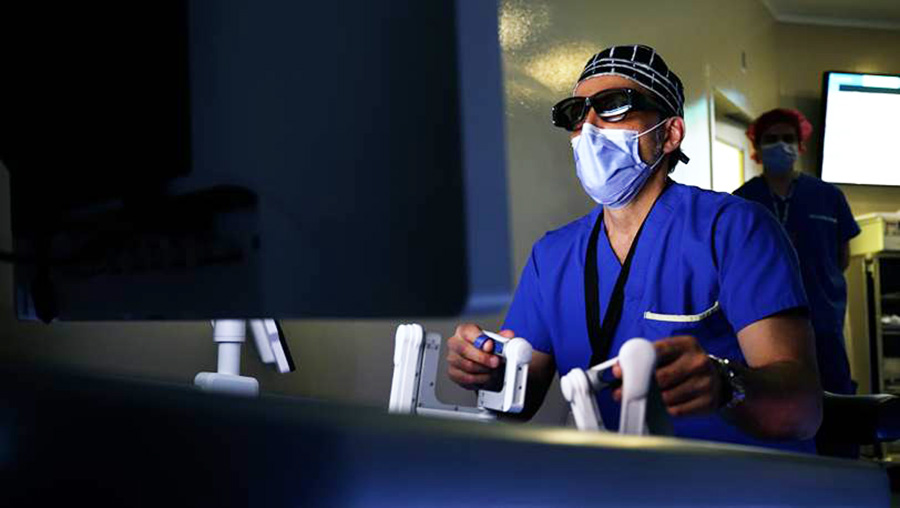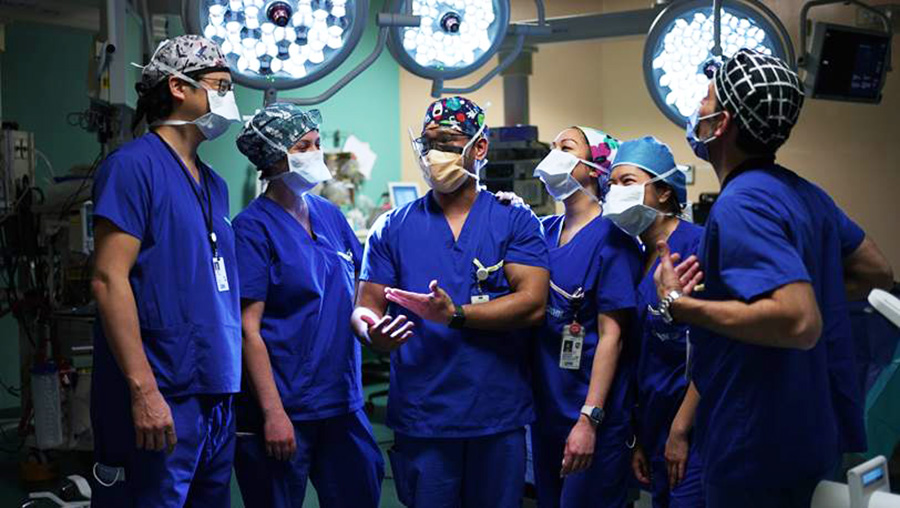
The robots have come, and with them, the age of innovation has fully arrived to the Sprott Department of Surgery at UHN.
Within the span of a few weeks, multiple North American and Canadian first procedures were successfully conducted and patients who would normally have lengthier surgeries, longer and more painful recoveries, are now going home with minimal scars and fewer days in hospital.
“This is a magical time with respect to the robotic program,” says Dr. Thomas Forbes, Surgeon-in-Chief, Sprott Department of Surgery at UHN. “We’re advancing the number of robots significantly and we’re bringing in the most modern and up to date platforms.
“Our team-based approach to robotic surgery is very important. There’s been specific training with respect to our nurses, our technicians and our surgeons, and they’re all world leaders.”
Drs. Tony Finelli and Jason Lee, Chaya Shwaartz, Allan Okrainec and Sami Chadi, and Marcus Bernardini and Genevieve Bouchard-Fortier, led teams that utilized the new Medtronic Hugo and Da Vinci Xi robots.
“We are pushing the boundaries of robotic surgery, minimally invasive surgery,” says Dr. Lee, urologist, Sprott Department of Surgery at UHN. “We can offer our patients cutting edge technologies that may not be available anywhere else.
“We were really thrilled to be able to offer our patients the first North American commercial, Hugo robotic-assisted surgical procedure recently. We’re lucky to have an amazing nursing team, and they were instrumental in making sure that the day went smoothly. Without them, I don’t think it would have gone as well as it did. The new robotics platform is great and the team was ready, so it was a fun day.”
Multi-disciplinary teams spent months, and up to a year or more for some, training at the Temerty Advanced Surgical Education and Simulation Centre at the Michener Institute of Education at UHN, to use the eventual platforms. And, the teamwork certainly made the dream work, as one successful surgery after another took place recently in Toronto General Hospital’s operating rooms.
The robots have arrived and history is being made. (Video: UHN)
The Temerty Simulation Centre is one of the many reasons why learners, of many different levels of education and experience, are attracted to UHN.
“The first time I used a robot, it was an incredible experience,” says general surgeon Dr. Okrainec, Director, Temerty Advanced Surgical Education and Simulation Centre, Surgical Lead Planning and Infrastructure, UHN. “To be able to sit comfortably at a console close to the patient but not at the operating room table was really different, and it’s just very accurate, precise, very elegant to use.”
The myriad benefits to the patients, and the potential to grow the scale of the platforms to include artificial intelligence (AI), are only some of the reasons for excitement in the robotics program at UHN.
“The Temerty Simulation Centre is planning to be a centre of excellence for robotic training, working with various industry partners to have all different kinds of robots,” says Karen Chaiton, Senior Director, Infrastructure and Academic Linkages, the Michener Institute of Education at UHN.
“There’s still a lot of advancement within robotics. So right now the robots are controlled by the surgeon generally from a console or from different placement of the robot, so it’s not really operating on its own. Eventually you’ll see much more artificial intelligence layered into it, and so you can imagine that in the future a robot might close on a case.”
Robotic surgery has long been a passion for urologic oncologist, Dr. Tony Finelli, Head, Division of Urology, Sprott Department of Surgery at UHN. More than a decade of investigation, education, and developed expertise have cemented his leadership role in this space.
“What excites me about the robot, and why I’m passionate about it, is that it allows me to be a better surgeon in general,” says Dr. Finelli. “The surgery is associated with less harm to patients and morbidity side effects.
“In general, there are smaller incisions, less blood loss, faster recovery, less need for pain medication, and hopefully getting them back to a normal life as soon as possible.”
In the end, the use of robotics is driven by the passion of clinicians, the needs of patients, and UHN’s commitment to leading in this space.
“One of the amazing things about UHN is that we have a responsibility not only to provide excellence and care, but also to lead the charge on innovation and research,” says Dr. Fayez Quereshy, Vice President, Clinical, UHN. “How are we actually creating a pathway for others to follow? And then, also for us to create curricula and education, to train the next generation of surgeons.
“And by moving in this space, by adopting new technologies, by pushing the envelope on robotics, which is where I think the future is going, we will have been at the head of the pack, as opposed to being followers.”

